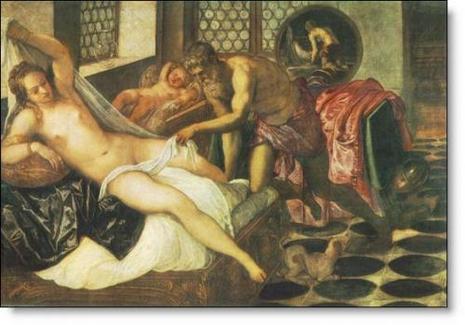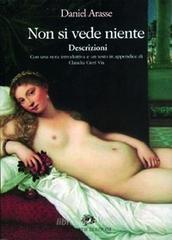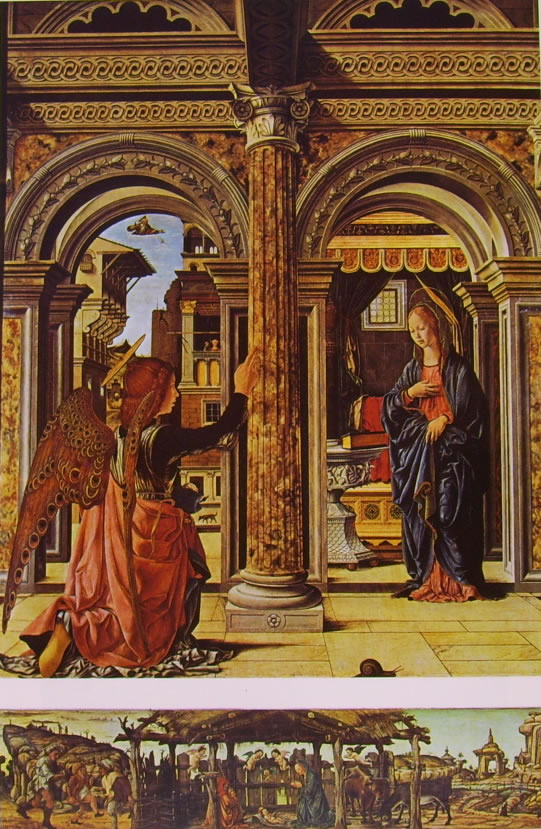Dedicated to my son Romain
che questo libro lo deve studiare
Gli occhiali inebriati di Daniel Arasse
Vous y voyez beaucoup trop
P ortava gli occhiali, Arasse? Penso di no, oppure come me, sì, di quelli da lettura per veder bene le immagini, magari aggiungendo una loupe , una lente di ingrandimento, come faccio io quando voglio vedere per bene un certo dettaglio che mi era completamente sfuggito fino a un attimo prima. E infatti, eccola, l'ho trovata una piccola foto che lo ritrae con quei tipici occhiali da presbite.
Vorrei parlare di un suo libro che pochissimi avranno letto in Italia. L'originale s'intitola On n'y voit rien (non si vede nulla) ed è stato pubblicato nel 2000.
Daniel ora non può replicare a nessuno, è morto nel 2003, a soli 59 years, because of the SLA [1].
was an art historian, irreverent, opinionated, friendly, enthusiastic, curious, educated and passionate, sometimes delirious, or as he liked to call himself (accusing others to define it that way, but in fact, gloating in) : sur-interpretant, someone who not only play a part, but goes beyond, goes further: overinterpretation. As someone who is trained in the sport too much and goes to overtraining. Typically, in these cases, the athlete who has exaggerated a few breaks a bone or ligament. Who knows ...
was an art historian, irreverent, opinionated, friendly, enthusiastic, curious, educated and passionate, sometimes delirious, or as he liked to call himself (accusing others to define it that way, but in fact, gloating in) : sur-interpretant, someone who not only play a part, but goes beyond, goes further: overinterpretation. As someone who is trained in the sport too much and goes to overtraining. Typically, in these cases, the athlete who has exaggerated a few breaks a bone or ligament. Who knows ...
This premise for honesty towards di chi legge. A Daniel Arasse do il grande merito di appassionare chi legge quel che scrive. Se chi legge è appassionato di suo.
(prima copertina: davvero non si vede niente!)
E entriamo finalmente nel libro, che ha come sottotitolo l'eloquente Descriptions .
* * *
Due sono le bugie that accompany this essay: the first is that it is a book of few pages and then quickly archived and the second is that it is written in a style so simple that it seems almost superficial.
This book is a rather short and dense. And the style is deliberately appealing, precisely because that was the personality of man Arasse, but also because the contents are like those offered to us thinking that guzzled wine that will not do anything wrong and that on the morrow we leave a heavy head , thinking and sore.
(second cover: here we see something, but little)
He has divided the book into 6 parts, each of which corresponds to a picture, each one has a different subject (je / I, you / you, he / him, on / yes, nous / us) is on his own, talk to someone, talking to himself, someone speaks to him ...
List of paintings and authors (if any) for each chapter (each with a suggestive title):
- Cara Giulia ( Mars and Venus surprised by Vulcan of Tintoretto )
- The eye of the snail ( The Annunciation of Cossa )
- A black eye ( Adoration of the Magi Bruegel )
- The level of Maddalena
- The woman in the trunk ( The Venus of Urbino Titian of )
- The eye of the master ( Velazquez Las Meninas of ).
I do not care to summarize the chapters, for that, buy the book, there is in the Italian version [recommend him a priori, I do not know whether he has a good translation or not , however, by (I quote as it is written) Dell'Ariccia A. ( sic)]. Here, I put the cover of the book published by publisher Artemis.
What interests me is not to explain, but the lure of painting, its enjoyment, by the look and feel of a Daniel Arasse about certain details that elude most.
[And whether you view, repeated prove the terms of the same semantic field (eye gaze and repeated twice)].
Arasse Daniel did not like to annoy others. Probably because he does not get bored first. So the structure of its chapters in different ways.
The first is written as a letter to a fellow self-styled Roman, known under the name of Julia (a seemingly affectionate letter, in fact, he gives the "blind", the worst insult for those who view makes the instrument a number of their profession, I can not see).
The second chapter addresses the public - or at least to those among his readers that reproach. Brings up a friend, an eminent scholar of semiotics and medieval historian, this Umberto (do not remember anyone?). To do agree with him on a subject that then he will reveal himself to be a solemn corner.
The prestigious École française de Rome
di cui Arasse è stato membro (1971-19743)
occupa il secondo piano di Palazzo Farnese a Roma
Nel terzo capitolo parla di sé in terza persona; nel quarto reintroduce un prepotente e aggressivo*io* contro un dispettosissimo *voi* (che non prende mai la parola, sia esso singolare o plurale).
E se nel quinto capitolo inscena una lite continua con uno studioso d'arte palesemente italiano, ma di cui non viene mai fatto il nome (Federico Zeri, forse?), the last gives you beautiful * you *.
L ' French Institute of Florence
Arasse which he directed from 1982 to 1989
What artistic touch schizophrenia. But I'm stylistic tricks , as I said, to rekindle the flame of his say.
His say. Personally, from the bottom of my art history knowledge are not always (to be frank, almost never) agree with the conclusions of Arasse (some of which I am going to expose), but I like the reasoning, logic deragliante though, the passion, the call - even the tug - that gives the reader to memorize the details under your nose that none of us had VISA (or not in that way).
 Take the first picture ( Mars and Venus surprised by Vulcan ): Arasse agrees with its target (and colleague ) Julia, who on the board of Tintoretto s'ignorano finanche le origini e le condizioni della committenza.
Take the first picture ( Mars and Venus surprised by Vulcan ): Arasse agrees with its target (and colleague ) Julia, who on the board of Tintoretto s'ignorano finanche le origini e le condizioni della committenza. Eppure, si lancia in una serie di argomentazioni che lo portano a concludere che tale dipinto sarebbe stato posto dal suo proprietario (a tutt'oggi anonimo, 1550 ca., si trova ora a Monaco di Baviera) , f orse - dice lui - la cortigiana di un giovane Gonzaga , in un salone, sotto gli occhi di tutti, per condividere con gli ospiti la vena ironica - anzi, la vis comica - del suo soggetto. E il quadro è rimasto pressoché sconosciuto fino al 1682... Si guardi il dipinto in questione. Dov'è that makes you laugh? According Arasse, Mars is - among others - ridiculously hidden under the table (like a modern lover in a closet), but the game would go, as a greenish Vulcan's all got to discover the crack the spouse .. .
And so on. Twenty-seven pages in which the reader is pleased to follow and does a constant coming and going between his words and images that the framework proposed by Tintoretto ( and we laugh with him but also with Cupid, Cupid, Eros that if it is lying in a cot under the window).
And why is it so important to the long hair of Mary Magdalene? In fact, Daniel principle with its fleece and with his mane and moves arguments between a partisan tantinello pilus et capillus .
But it is interesting to compare its where it says that the virility of women passing through the length of the hair.
Actually the right word would be another ... if this word existed. In fact, there is male and female, male and female, man and woman. But what is in contrast to the word manhood? means more feminine. At most, was coined virago (from vir, man) but with distinctly pejorative sense.
Okay, let's go further.
that the hair in any way represent the status of the force (not in the sense of the muscles, of course, what you see Samson & Delilah ) is not far-fetched.
Remember What did the women who went to bed with the enemy, at the end of the war? At collaborationist, he shaved his skull. Took off all their hair. The stripped off their dignity (more than the nudity!).
Remember What did the women who went to bed with the enemy, at the end of the war? At collaborationist, he shaved his skull. Took off all their hair. The stripped off their dignity (more than the nudity!).
Two, however, are the characteristics of Mary Magdalene: One, we saw, the other is crying.
always cries. Who remembers the chant: I come from Jerusalem, no ride 'without weeping , which involved child play in repeating these words without ever laugh? Here is Mary Magdalene beat everyone. She never laughs, she always cries. Not surprisingly, the few Parisian fountains that distribute free water, fountains, green ones, the Wallace (named after its inventor) and seem to cry as Maddalene, gave the cue to Jean-Pierre Jeunet, the ; director of Amélie Poulain, to call the character of the door, forever crying, Madeleine Wallace.
Arasse Returning to the historian infers that Mary Magdalene - which she is social and collective imagination - does not exist. It would be a composite f IGURE around which they later built a legend with even a rumor, that of his real relationship with Christ.
Legend has caught on well, on the other hand, plays music, novels danbrowniani ... and so on.
Legend has caught on well, on the other hand, plays music, novels danbrowniani ... and so on.
It is a dogma, a mystery. And repair the Church provides for women, in partial compensation of the image of Eve. Although it remains a figure ancillary (but notice that if, for this reason, we have to wait even centuries).
Get ready, it produces a different picture, but only for a flash . What? (And yes, I was plagued by technical Arasse) ... Are you saying "Ugh, another picture that is very well known, yet another variation of the 'Adoration of the Magi (1564, find it in London), this time in the sauce that crazy Bruegel ... The Old or young, boh, who knows how to distinguish them. "
Yes, yes. Meanwhile Pieter Bruegel the Elder . But you look Gaspar, his eye black, you notice? Not me. In fact, I had not even noticed, Gaspare. I had to take a lens and then get back to read what he writes about Daniel Arasse: the only black among Whites, the only one (apart from Madonna and Child) is not ridiculed.
The thrill, however, gave me a snail, that Francesco Cossa include in its German Annunciation (1470, is located in Dresden). What is there to make a tiny snail on the edge of a picture? Nor is there any! Ecché, he lacked the space?
Well, the art historian moves all reserves (it asks questions and gives answers): "But you know what it means to a escargot, a snail , placed at the outset of the picture! ... who are you looking for? The snail is the symbol of fertility and is to indicate the occurrence of the immaculate conception, everyone knows it!
think himself to be intimidated by the response? Not at all.
strokes of argument, Arasse explains it, the snail, invites us to enter another world, leaving our world, but also warns us that "we should not capture the illusion of what we see we must not believe it, "in short.
We finish with a flourish with the Venus of Urbino and Las Meninas. I do not dwell, my post is already so long.
I suggestive of assumption to say that the historian in this regard that the bed is a bed and drape a cloth that is not the Titian's Venus I straciccio together with the delirium of the drawer (which often beautiful, though) and I still its interesting but not different reading of the iconoclastic meninas Foucault (who you like, we are increasingly post-modern!).
suggest buying the book, I urge reading which has the great merit of being pleasant and, most importantly, inspiring. And we know that stimulate the brain keeps you young (flexible, at least).
PS greet the gentleman in the background of the last picture (and with it immediately remember it's a famous story Tabucchi).
Saint-Cloud, 14 July 2010
All rights reserved
Jacqueline Spaccini © 2010
___________
[1] ALS: amyotrophic lateral sclerosis [to Stephen Hawking, Luca Coscioni, bassist Mike Porcaro, David Niven and many players, like Stefano Borgonovo (currently there are 35 cases of deaths from ALS among players in Italian)].











0 comments:
Post a Comment